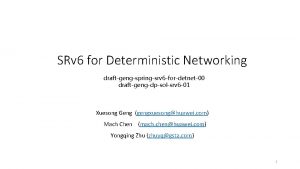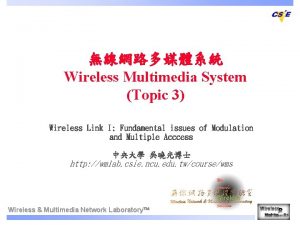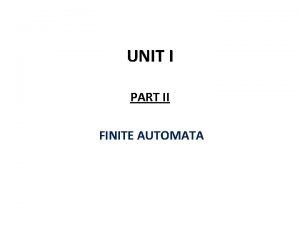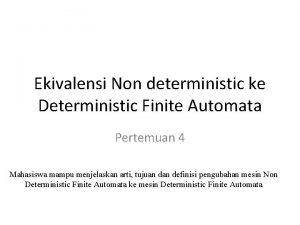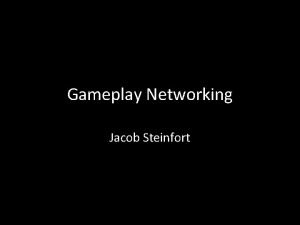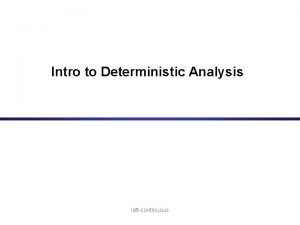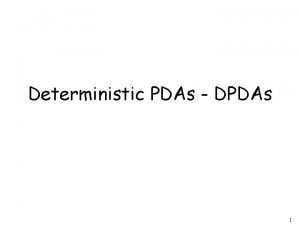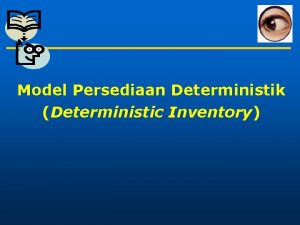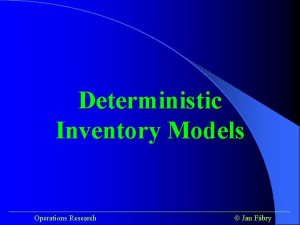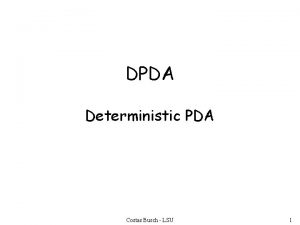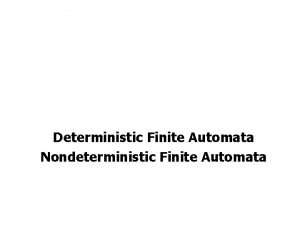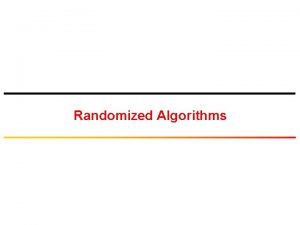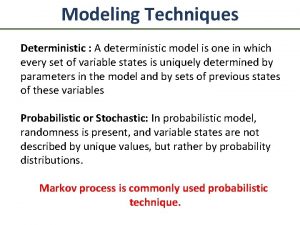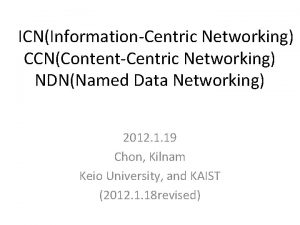SRv 6 for Deterministic Networking draftgengspringsrv 6 fordetnet00















- Slides: 15

SRv 6 for Deterministic Networking draft-geng-spring-srv 6 -for-detnet-00 draft-geng-dp-sol-srv 6 -01 Xuesong Geng (gengxuesong@huawei. com) Mach Chen (mach. chen@huawei. com) Yongqing Zhu (zhuyq@gsta. com) 1

Why Deterministic Networking? • New Applications in 5 G • AR, VR • Industry • Io. T • New Requirement for Network • Strict SLA Guarantee: E 2 E Latency, Reliability… • New Technologies? • Deterministic Networking(Det. Net) • Det. Net provides a capability to carry specified data flows for real-time applications with extremely low data loss rates and bounded latency within a network domain 2

Det. Net Overview • Key Technologies • Resource Allocation: • e. g. , buffer space or link bandwidth, for Det. Net flow • Resource allocation addresses two of the Det. Net Qo. S requirements: latency and no congestion loss packet loss. • Service Protection: • Det. Net flow is replicated and transmitted through non-parallel paths at the same time • Redundant Det. Net flows are eliminated in a merge node. • No packet loss when one of the path fails compared to traditional switchover from active path to standby path • Explicit Route: • The paths are typically explicit routes so that they do not normally suffer temporary interruptions caused by the convergence of routing 3

Implement Det. Net in an SRv 6 Domain • Why SRv 6? • Source Routing: SRv 6 could steer the Det. Net flows through the network according to an explicit path with allocated resources; • Network Programming: SRv 6 applies instructions (functions) to packets in some special nodes (or even all the nodes) along the path in order to guarantee, e. g. , service protection and congestion protection. • Meta Data: SRH TLVs support meta-data for segment processing, which could be used to carry Det. Net meta data, e. g. , flow identification and sequence number. • Why not? ! *RFC 8402: Segment Routing Architecture *draft-ietf-6 man-segment-routing-header-26: IPv 6 Segment Routing Header (SRH) 4

SRv 6 for Det. Net Service Protection Data Plane Replicates the payload and IPv 6 Header with the SRH Binding two different SRv 6 Policies respectively Eliminates the redundant packets. Binds a new SRv 6 Policy to the survival packet, which steers the packet from Relay Node 2 to Egress. Inserts the SRv 6 Policy that will steer the packet from Ingress to the destination. Flow Identification and Sequence Number are carried in the SRH Control Plane Controller->Edge node: Computes a P 2 MP 2 P path, including replication nodes and elimination nodes. Send the path computation result to the edge node through PCEP/BGP extensions Decapsulates the outer Ipv 6 header. Sends the inter packet to the End Station 2. Edge node->Controller: Sends a path computation requirement containing that service protection in order to have ultra-reliability through PCEP/BGP extensions. Controller->Relay Node : Replication node and elimination node should be configured to identify Det. Net flows by flow identifications; After replication or elimination, the explicit path to the next relay is also required 5 through BGP extensions or Netconf YANG.

Det. Net SRv 6 Data Plane Requirement • A method of identifying the Det. Net payload type; • A suitable explicit route to deliver the Det. Net flow ; (e. g. , Segment List in SRH) • A method of indicating packet processing, such as PREOF; (detailed in next slides) • A method of identifying the Det. Net flow; (detailed in next slides) • A method of carrying Det. Net sequence number; (detailed in next slides) • A method of carrying queuing and forwarding indication to do congestion protection; (not now) 6

Det. Net SRv 6 Data Plane Solution Flow Identification(20 bits) and Sequence Number(28 bits) are carried in: • Option 1: SRH TLVs 2 • Opiton 2 : arguments in the SID for Relay Node • Option 3: Det. Net SID in segment list • Option 4: Det. Net SRH inside the SRH (Not Reasonable) 3 1 4 Next Header 7

SRv 6 Data Plane Solution Option 1 -Encapsulation • Flow Identification(32 bits) and Sequence Number(32 bits) are carried as TLVs SID for Relay Node IPv 6 Header • • SRH Type: 8 bits, to be assigned by IANA. Length: 8. RESERVED: 28 bits, MUST be 0 on transmission and ignored on receipt. Flow Identification: 20 bits, which is used for identifying Det. Net flow. IPv 6 Header Payload • • Type: 8 bits, to be assigned by IANA. Length: 8. RESERVED: 20 bits. MUST be 0 on transmission and ignored on receipt. Sequence Number: 28 bits, which is used for indicating sequence number of a Det. Net flow. 8

SRv 6 Data Plane Solution Option 1 -Replication Function • End. B. Replication: Packet Replication Function 1. IF NH=SRH & SL>0 THEN 2. extract the Det. Net TLV values from the SRH 3. create two new outer IPv 6+SRH headers: IPv 6 -SRH-1 and IPv 6 -SRH-2; Insert the policy-instructed segment lists in each newly created SRH (SRH-1 and SRH-2). Also, add the extracted Det. Net TLVs into SRH-1 and SRH-2. 4. remove the incoming outer IPv 6+SRH header. 5. create a duplication of the incoming packet. 6. encapsulate the original packet into the first outer IPv 6+SRH header: (IPv 6 -SRH-1) (original packet) 7. encapsulate the duplicate packet into the second outer IPv 6+SRH header: (IPv 6 -SRH-2) (duplicate packet) 8. set the IPv 6 SA as the local address of this node. 9. set the IPv 6 DA of IPv 6 -SRH-1 to the first segment of the SRv 6 Policy in of SRH-1 segment list. 10. set the IPv 6 DA of IPv 6 -SRH-2 to the first segment of the SRv 6 Policy in of SRH-2 segment list. 11. ELSE 12. drop the packet 9

SRv 6 Data Plane Solution Option 2 -Elimination Function • End. B. Elimination: Packet Elimination Function 1. IF NH=SRH & SL>0 & "the packet is not a redundant packet" , THEN 2. do not decrement SL nor update the IPv 6 DA with SRH[SL] 3. extract the value of Det. Net TLVs from the SRH 4. create a new outer IPv 6+SRH header 5. insert the policy-instructed segment lists in the newly create SRH and add the retrieved Det. Net TLVs in the newly created SRH 6. remove the incoming outer IPv 6+SRH header. 7. set the IPv 6 DA to the first segment of the SRv 6 Policy in the newly created SRH 8. ELSE 9. drop the packet 10

Det. Net SRv 6 Data Plane Solution Example SRv 6 (R 1, T 2) IPv 6 (In, R 1) (R 2, T 2; SL=1) (R 1, T 1; SL=1) (ES 1, ES 2) T 1 (ES 1, ES 2) In End Station 1 (In, T 1) (ES 1, ES 2) (R 1, T 1; SL=2) (ES 1, ES 2) T 2 R 1 (R 1, T 2) (R 2, T 2; SL=2) (ES 1, ES 2) T 3 (R 1, T 3) (R 2, T 3; SL=1) IPv 6 (R 2, T 4) (Eg, T 4; SL=2) (ES 1, ES 2) R 2 T 4 (R 2, Eg) (Eg, T 4; SL=1) (ES 1, ES 2) Eg End Station 2 (ES 1, ES 2) (R 1, T 3) (R 2, T 3; SL=2) (ES 1, ES 2) 11

Next Step • Collect Feedback from SPRING • Comments and discussions in the mailing list • Seek for Corporation 12

Thanks 13

SRv 6 Based PREOF SRv 6 IPv 6 Header 2 SRH 2 IPv 6 Header IPv 6 Transit Node 1 End Station 1 Relay Node 1 [Replication] Ingress IPv 6 Header 1 SRH 1 IPv 6 Header Transit Node 2 IPv 6 Header 1 SRH 1 IPv 6 Header 3 SRH 3 IPv 6 Header Relay Node 2 [Elimination] IPv 6 Header 4 SRH 4 IPv 6 Header Egress IPv 6 Header 4 SRH 4 IPv 6 Header End Station 2 IPv 6 Header 14

SRv 6 based Det. Net • SRv 6 Network Programming: • • Service Protection: • Carry Flow Identification and Sequence Number in optional TLV; • Define new functions for packet replication & elimination Resource Allocation • • Sequence Number TLV Flow Identification TLV Define new functions for scheduling/reserved resource Explicit Path • SID List indicates the explicit route Next Header Hdr Ext Len Last Entry Flags Routing Type Segment Left Tags Segment List[0] Segment List[1] SRv 6 SID List … Segment List[n] Optional TLV SRv 6 SID (128 bit) Locator Function (ARG) New functions for Det. Net, e. g. , packet 15 replication /elimination / scheduling
 Srv in networking
Srv in networking Srv intra
Srv intra Sdn architecture vs traditional network
Sdn architecture vs traditional network Deterministic
Deterministic Statistical versus deterministic relationship
Statistical versus deterministic relationship Statistical versus deterministic relationship
Statistical versus deterministic relationship Statistical versus deterministic relationship
Statistical versus deterministic relationship Non deterministic algorithm for sorting
Non deterministic algorithm for sorting Dfa stands for in automata
Dfa stands for in automata Deterministic vs stochastic environment examples
Deterministic vs stochastic environment examples Non-deterministic algorithm
Non-deterministic algorithm Deterministic finite automata adalah
Deterministic finite automata adalah State yang merupakan non-deterministic ditandai dengan
State yang merupakan non-deterministic ditandai dengan Deterministic lockstep
Deterministic lockstep Non-deterministic algorithm
Non-deterministic algorithm Deterministic games examples
Deterministic games examples
